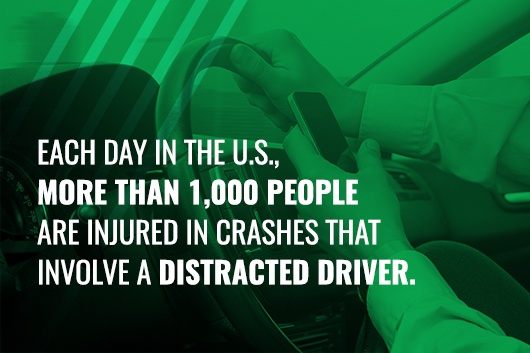
Distracted driving was directly responsible for 23,000 deaths and well over a million injuries in the U.S. between 2012 and 2018, according to the National Highway Traffic Safety Administration (NHTSA). And according to the Network of Employers for Traffic Safety, distracted driving-related crashes cost employers a staggering $18.8 billion in 2019.
But despite all the attention given to the dangers of distracted driving, driving statistics indicate that too many drivers aren't taking these dangers seriously.
An increasing number of distractions are adding to the problem. While most of us think of cell phones when we think of distracted driving, there are many different types of distracted driving. Checking GPS and navigation systems, changing the radio station or music, searching for controls in your vehicle, eating, drinking, and even experiencing stress and fatigue can play a part in distracted driving. In fact, anything that takes your mind and focus away from driving is considered a distraction.
What Is Distracted Driving?The NHTSA defines distracted driving as any non-driving activity that occurs behind the wheel. It identifies the three types of distracted driving as:
- Visual: Taking your eyes off the road
- Manual: Taking your hands off the wheel
- Cognitive: Taking your mind off driving
Any of these forms of distracted driving will increase your risk and decrease your safety. No matter how safe a driver you are, you’re still affected by distracted driving. Although all of us are guilty of being distracted behind the wheel every now and then, you have a choice in how distracted you allow yourself to be.
You don’t even have to be the one who is distracted or careless behind the wheel to experience the effects. Other distracted drivers may cut you off in traffic, drift into your lane or take other unsafe actions that they’re not even aware of.

Distracted Driving Statistics and Facts
Part of knowing how to manage distracted driving is understanding how and when it happens. Let’s look at 10 important facts about distracted driving that all drivers should know before getting behind the wheel:
- More than 2.5 million people are involved in crashes each year, and distracted driving is the leading cause. By some estimates, as many as 1,000 people are injured every day in crashes related to distracted driving.
- Data suggests that deaths from traffic crashes are on the rise because of all the distractions drivers face. Distractions inside the car give us too many things to look at (and listen to) — from GPS devices and infotainment systems to cell phones and other electronics.
- Multitasking is a myth. Research shows that when you’re doing two things at once, your brain is actually just switching between tasks very rapidly. Every additional task you do while driving detracts from your ability to drive well and increases your chance of having a collision.
- It takes your brain up to 13 seconds to refocus on your surroundings after looking at your cell phone — even if you “only glanced at it for a second.” As your brain refocuses, your driving skills are not at their best.
- When you attempt to multitask while driving, your eye activity slows down and your problem-solving skills are diminished.
- Seventy-seven percent of vehicle crashes happen within 15 miles of your destination. When we get familiar with our surroundings, we tend to relax and let our guard down. Doing this makes us less alert to changes in the driving environment and more prone to distraction.
- A person who texts and drives is six times as likely to have a crash than someone who drives drunk.
- Eating while driving is riskier than talking on a cell phone. Food can cause problems like spills and leaks that demand your immediate attention and may cause you to take your eyes off the road. If you’re eating, you’re also taking at least one hand off the wheel, which reduces your ability to react to driving situations.
- According to the Federal Motor Carrier Safety Administration, 71% of large truck accidents occurred because the driver was doing something other than driving the truck.
- One study found that nearly 80% of crashes involved driver inattention in the three seconds right before the crash. The study also pointed to driver inattention as the leading factor in crashes and near-crashes.
Practicing Safety When Those Around You Aren’t
Even if you are following all the proper guidelines for safety, other drivers on the road with you may not be. Knowing these driving safety facts can help you avoid irresponsible drivers on the road.
Learning and applying The Smith5Keys® helps drivers prepare for and safely react to the dangerous actions of other drivers.
Want to learn more? With Smith System’s Driving Distracted video, drivers can learn how distracted driving affects their behavior and how to prepare for the actions of distracted drivers around them.











